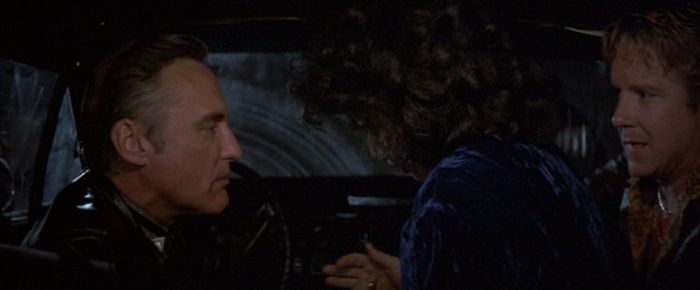 Back to selection
Back to selection
The Blue Velvet Project
Blue Velvet, 47 seconds at a time by Nicholas Rombes
The Blue Velvet Project, #106

Second #4982, 83:02
This frame comes from perhaps the most difficult scene to watch—without flinching or looking away—in Blue Velvet. Frank, getting warmed up for his violent gender-bending abuse of Jeffrey, assaults what is beneath Dorothy’s robe. The viewer is trapped in the backseat with Jeffrey, sutured into his point of view. Jeffrey, who is unable to decipher the meaning of Frank. On one level, Blue Velvet is a post-apocalyptic film, where what has been destroyed is not just buildings but meaning itself. In Brian Evenson’s new novel Immobility, the main character—a paralyzed-from-the-waste-down man named Horkai—considers the devastated landscape as he is being carried to a destination he does not know:
An old rest area, rusty metal rail still in place, the building itself having fallen off its foundations to spill into the parking lot. A sudden unbroken run of telephone poles, most snapped off partway down but a few still relatively intact. And then a few more houses, these almost unpleasantly big, at least if their rubble was any indication. Perhaps condos rather than individual houses, impossible now to say. A triangular sign with the silhouette of an animal—a deer, perhaps—crudely painted on it.
If we look at Blue Velvet slightly askance, and tune into its low frequencies, we can detect the contours of a different genre, a sort of apocalyptic retro-futurism. The apartment buildings and warehouses devoid of residents except for Dorothy and Frank. The odd feeling that the film is not set in any specific historical moment. Frank’s radical disappearing act at Ben’s apartment. The impossibility of Sandy. Her father, Detective Williams, dressed in his work outfit—gun holster and all—at night at home when he’s off-duty. The mechanical robin at the film’s end (echoed, perhaps, in Haruki Murakami’s The Wind-Up Bird Chronicle, published roughly a decade after Blue Velvet).
But in this frame, it all comes down to Frank’s face, his set-jaw determinism. Although his profile is illuminated it may as well be a void, an absence. At this moment, more than any other, he is the black hole at the core of the film, evacuating all love, all tenderness from the frame.
Over the period of one full year — three days per week — The Blue Velvet Project will seize a frame every 47 seconds of David Lynch’s classic to explore. These posts will run until second 7,200 in August 2012. For a complete archive of the project, click here. And here is the introduction to the project.
